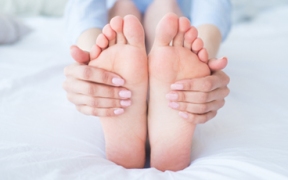Properly fitted shoes can help reduce the risk of foot and ankle injuries and deformities. Steven Jasonowicz, DPM, and Cathy Irwin, PT, OCS, MHS, of Illinois Bone & Joint Institute, give advice on how your shoes should fit and the deformities that could arise from wearing poor-fitting shoes.
The fit of the shoe should be “snug without pinching,” says Irwin. You should not force your foot into a shoe that does not have a similar natural shape. Irwin says, “a straight foot needs a straight shoe, and a curved foot needs a curved shoe.”
Irwin recommends checking the following when buying shoes:
- Stiffness of the sole. The shoe should not be able to bend in half or be twisted in the arch. It should bend where your toes start, not in the arch (middle) of the shoe.
- Heel counter. The heel should offer some resistance when squeezing it.
- Size of toe box. Square toe boxes provide the most room, round toe boxes provide some room, and pointed toe boxes provide the least amount of room for your toes.
- Depth of toe box. This is the height from the sole to the top of the shoe. Toes should not be scrunched in this area; they should have some room to move. Shoes with a narrow or tight toe box can aggravate bunions and cause blisters or sores.
Irwin also says to look for shoes made with materials like soft leather which allows for more expansion in the toe box, accommodating deformities like bunions. If you have to wear heels, opt for a heel that is two inches or less, has a thick or wedged heel, and if possible, has a strap around the ankle or arch. Shoes with straps, buckles, or laces provide more stability.
Jasonowicz explains that “wearing the wrong shoes can not only be the culprit causing foot and ankle problems but can aggravate underlying deformity. Wearing the wrong shoes can change the way pressure is normally distributed in the foot. This can put extra pressure on the bones and soft tissue structures, it’s not uncommon to see stress fractures, neuromas, and plantar fasciitis from wearing the wrong shoes.”
Jasonowicz sees these common conditions that could be exacerbated by shoes:
- Bunions
- Corns
- Hammer toes
- Crossover toes
- Neuromas
- Flat feet
- High-arched feet
- Plantar fasciitis
- Insertional Achilles tendinitis
Jasonowicz says the best way to reduce your risk of developing foot deformities is by “getting properly fitted/sized for shoes. Sometimes you may require an insert or orthotic to accommodate a specific condition or deformity. It is ok to wear less supportive or more stylish shoes occasionally, but try and limit your time in these types of shoes.”
Jasonowicz adds, “People with diabetes and those patients with peripheral neuropathy need to be extremely careful with shoes. Something simple like a blister from an area of rubbing can result in a difficult-to-heal sore or even infection. Those with diabetes or peripheral neuropathy need to check their feet daily and let their doctor know right away if they are having any issues.”
If you are experiencing foot pain, Irwin provides simple exercises to help reduce pain:
- Toe spreading and stretching
- Golf ball roll
- Bending toes forward and backward
- Massaging
- Calf stretch
- Tracing the alphabet with your foot
- Practicing balance
“Listen to your feet. If something hurts, avoid wearing those shoes in the future,” Jasonowicz says. Everyone’s feet are different. Try on multiple shoes in your foot style to compare what feels best.
 Steven Jasonowicz, DPM
Steven Jasonowicz, DPMDr. Steven Jasonowicz is a podiatric foot and ankle surgeon providing diagnosis and treatment for the full spectrum of foot and ankle disorders.




